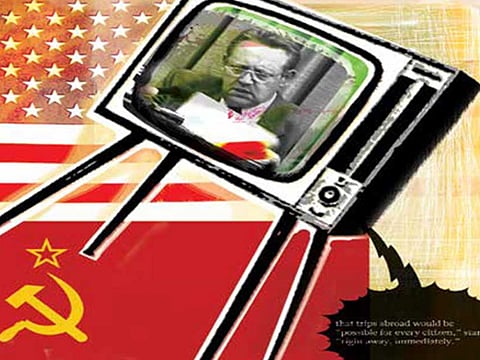How the Berlin Wall Really Fell
America deserves some credit, but not for the reasons one might think

The opening of the Berlin Wall, 25 years ago this Sunday, marked a surprisingly joyous end to a conflict that could have erupted into thermonuclear combat. In the decades since, many Americans have come to believe that the wall fell thanks to President Ronald Reagan’s personal intervention. In a 1987 speech in front of the Brandenburg Gate in Berlin, he told Soviet leaders to “tear down this wall” — and so, we’ve been told, they did.
This misreading of the actual fall of the wall is, at best, incomplete; at worst, it’s dangerous, contributing to the belief that American leaders can go “from Berlin to Baghdad,” shaping world events while ignoring the complex realities of the locals.
In truth, the opening of the Berlin Wall on the night of November 9, 1989, was not planned. Well into that year, East Germany remained nearly inescapable: The last killing by a guard at the wall occurred in February 1989. So what happened to make this heavily armed border open literally overnight? The answer lies in a series of mistakes by East German officials. These errors threw off sparks into the tense atmosphere of autumn 1989, already supercharged by the rise of an East German resistance movement and the collapse of the ruling regime.
It was the Soviet leader Mikhail S. Gorbachev who had opened the door to these events. In his four years in power, he had introduced a series of social and political reforms across Soviet-controlled Eastern Europe — but to enhance Communist control, not end it.
These reforms put the hard-line dictators in East Germany in a bind. They felt they had to make some sort of concession, too. Politburo members in East Berlin decided to make minor changes to the state’s draconian travel rules — but to retain the power to deny travel permission on a whim. The announcement of this pseudo-reform, at a news conference televised on November 9, was botched. The bumbling Politburo member running the conference, Günter Schabowski, read the news release for the first time on air. Much of his reading was garbled, but a few phrases popped out: that trips abroad would be “possible for every citizen,” starting “right away, immediately.” Shorn of their context, these phrases mistakenly gave journalists and TV viewers the impression that the wall was open.
But his error need not have been fatal. Politburo members making mistakes was nothing new, and the bottom line had not changed. What had changed was the self-assurance of the people. By autumn 1989, the protest movement had gained the confidence to take advantage of this incompetence. The people already knew the authorities would back down: A month earlier, protesters in Leipzig had turned out in such overwhelming numbers that the security forces, which we now know had planned a Tiananmen-style crackdown, had backed off.
And they knew they could trust each other. Stasi interrogators had once asked a prisoner named Katrin Hattenhauer how the dissidents held together. She replied that shared suffering welded people together more strongly than shared success: “Where the hammer has come down, whatever is underneath is going to hold together.”
In contrast, members of the regime did not trust their colleagues, or their subordinates — and this lack of trust undermined their ability to blunt the rising revolution. And so, when tens of thousands of Berliners headed toward the wall after the news conference, the entire system cracked.
When one of the regime’s most loyal subordinates, a Stasi officer named Harald Jäger who was working the November 9 night shift at a crucial checkpoint in the Berlin Wall, repeatedly phoned his superiors with accurate reports of swelling crowds, they did not trust or believe him. They called him a delusional coward. Insulted, furious and frightened, he decided to let the crowds out, starting a chain reaction that swept across all of the checkpoints that night.
In short, the fall of the wall came about because of the complex interplay among Soviet reforms, East Berlin’s incompetence and, crucially, rising opposition from everyday Germans.
This doesn’t mean the West was irrelevant. The attractiveness of the freedoms of the West motivated large numbers of East Germans, who later voted for rapid German reunification on Western terms. And the support that the United States gave both its allies in Western Europe and dissidents in Eastern Europe over the course of the long Cold War helped to shape an environment in which the wall could open.
But that support did not open the barrier all by itself. Rather than congratulate itself for things that it did not do, on this anniversary Washington should learn from what it did do. Playing the long game, it helped to create a context in which locals could seize on opportunities to overcome their own dictators. That is indeed a success worth celebrating.
— New York Times News Service
Mary Elise Sarotte is a professor of history at the University of Southern California, a visiting professor at Harvard and the author, most recently, of “The Collapse: The Accidental Opening of the Berlin Wall.”
Sign up for the Daily Briefing
Get the latest news and updates straight to your inbox


